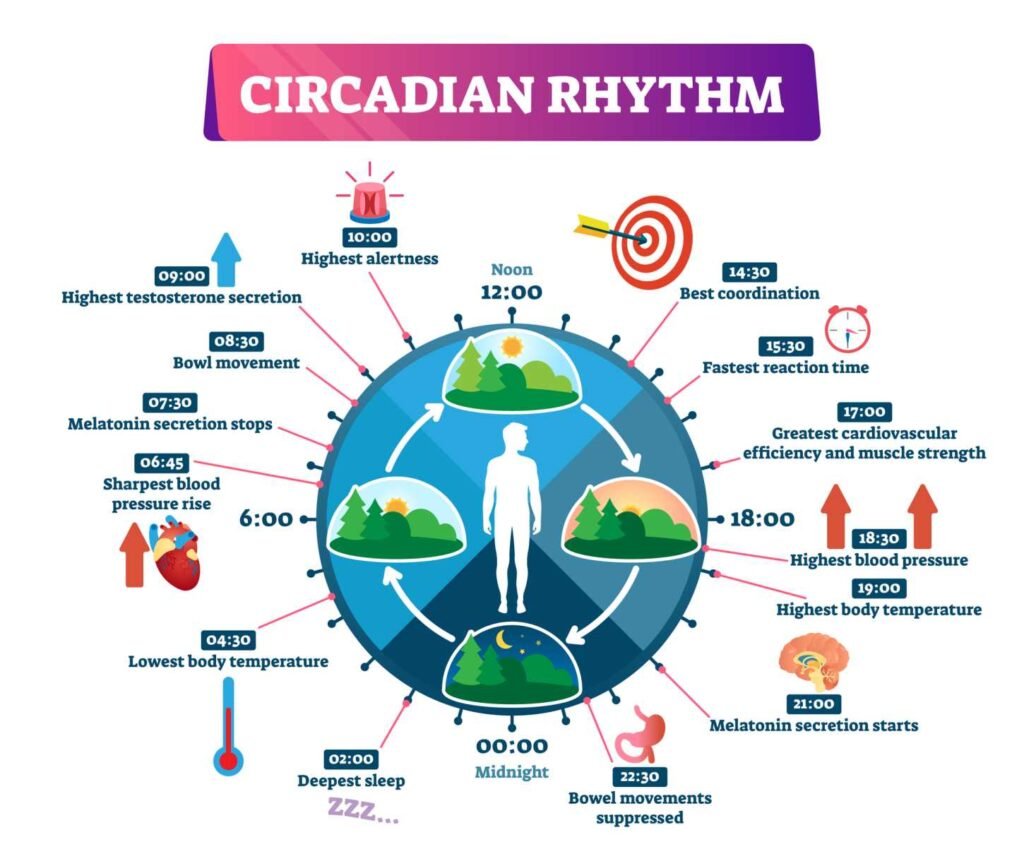Circadian dysrhythmia, also known as circadian rhythm disorder, is a condition that affects an individual’s internal clock.
The internal clock is responsible for regulating the body’s sleep-wake cycle, and when it is disrupted, it can lead to a variety of issues. These issues can include difficulty falling asleep or staying asleep, waking up too early or too late, and feeling tired or groggy during the day.
The internal clock is controlled by a part of the brain called the suprachiasmatic nucleus (SCN). The SCN receives input from light-sensitive cells in the eyes, which helps it to synchronize with the natural 24-hour cycle of daylight and darkness. However, disruptions to this cycle, such as shift work, jet lag, or exposure to artificial light at night, can throw off the internal clock and lead to circadian dysrhythmia. This can have negative effects on an individual’s health, including increased risk for depression, obesity, and cardiovascular disease.
Overall, circadian dysrhythmia is a complex condition that can have a significant impact on an individual’s quality of life. Understanding the causes and symptoms of this disorder is important for developing effective treatments and interventions to help those affected.

Understanding Circadian Dysrhythmia
Biological Basis of Circadian Rhythms
Circadian rhythms are biological processes that follow a 24-hour cycle and are regulated by the circadian clock located in the hypothalamus of the brain. This clock controls the sleep-wake cycle, hormone secretion, body temperature, and other physiological functions. The circadian clock is influenced by external cues such as light and social cues, but it can also operate independently.
The genes responsible for the circadian clock are known as clock genes and they regulate the expression of other genes involved in the biological processes of the body. The production of melatonin, a hormone that regulates sleep, is also controlled by the circadian clock. Disruptions to the circadian rhythm can lead to a range of health problems, including circadian rhythm disorders.
Common Circadian Rhythm Disorders
Circadian rhythm disorders are conditions that affect the normal sleep-wake cycle and can lead to sleep disturbances, fatigue, and other health problems. Some of the most common circadian rhythm disorders include:
- Delayed Sleep Phase Syndrome (DSPS): This condition is characterized by a delayed sleep-wake cycle, meaning the individual has difficulty falling asleep and waking up at the desired times.
- Advanced Sleep Phase Syndrome (ASPS): This condition is the opposite of DSPS, where the individual falls asleep and wakes up earlier than desired.
- Jet Lag: This occurs when an individual travels across different time zones, disrupting their circadian rhythm and causing sleep disturbances and fatigue.
- Shift Work Disorder: This occurs when an individual works non-traditional hours that disrupt their normal sleep-wake cycle.
Treatment for circadian rhythm disorders may include light therapy, melatonin supplements, and adjustments to sleep schedules. It is important to maintain a regular sleep-wake cycle and seek medical attention if symptoms persist.
Symptoms and Diagnosis
Identifying Symptoms of Dysrhythmia
Circadian dysrhythmia is a disorder that can affect an individual’s sleep-wake cycle, leading to difficulty falling asleep or staying awake at the appropriate times. The most common symptoms of dysrhythmia include daytime sleepiness, poor sleep quality, and excessive sleepiness during the day.
Individuals with dysrhythmia often experience difficulty falling asleep at night and may wake up frequently during the night. They may also feel tired or groggy during the day, even after getting a full night’s sleep. Other symptoms may include irritability, difficulty concentrating, and decreased performance at work or school.
Tools and Methods for Diagnosis
Diagnosing circadian dysrhythmia can be challenging, as the symptoms can be similar to those of other sleep disorders. Healthcare providers may use a variety of tools and methods to help diagnose dysrhythmia, including actigraphy and sleep diaries.
Actigraphy is a non-invasive method of monitoring sleep-wake patterns using a small device worn on the wrist. The device records movement and light exposure, which can be used to determine an individual’s sleep-wake patterns over a period of several days or weeks.
Sleep diaries are another useful tool for diagnosing dysrhythmia. Individuals are asked to keep a record of their sleep patterns, including the time they go to bed, the time they wake up, and any periods of wakefulness during the night. This information can be used to identify patterns of sleep disruption and help healthcare providers make a diagnosis.
In some cases, healthcare providers may also recommend a sleep study to help diagnose dysrhythmia. During a sleep study, an individual is monitored overnight in a sleep laboratory to assess their sleep-wake patterns and identify any underlying sleep disorders.
Overall, identifying the symptoms of dysrhythmia and using appropriate diagnostic tools and methods can help healthcare providers make an accurate diagnosis and develop an effective treatment plan for individuals with this disorder.
Treatment and Management
Lifestyle Modifications
For individuals with circadian dysrhythmia, making certain lifestyle modifications can be an effective way to manage and treat the condition. These modifications may include adopting healthy sleep habits, such as going to bed and waking up at the same time every day, avoiding caffeine and alcohol before bedtime, and creating a relaxing bedtime routine.
In addition to sleep habits, regular exercise and exposure to natural sunlight during the day can help regulate the body’s internal clock. This can be especially helpful for individuals who work night shifts or have irregular sleep schedules.
Medical Interventions
In some cases, lifestyle modifications alone may not be enough to manage circadian dysrhythmia. In these situations, medical interventions may be necessary.
One common treatment option is light therapy, which involves exposure to bright light in the morning or evening to help reset the body’s internal clock. Melatonin supplements may also be used to regulate sleep-wake cycles, although it is important to speak with a healthcare provider before starting any new supplement regimen.
Medications may also be prescribed to help manage symptoms of circadian dysrhythmia. Chronotherapy, which involves gradually adjusting sleep and wake times over several days, may also be effective for some individuals.
Cognitive-behavioral therapy may also be beneficial for individuals with circadian dysrhythmia. This type of therapy can help individuals identify and change negative thought patterns and behaviors that may be contributing to their sleep issues.
Overall, there are a variety of treatment options available for individuals with circadian dysrhythmia. Working with a healthcare provider to develop a personalized treatment plan that includes a combination of lifestyle modifications and medical interventions can be an effective way to manage the condition and improve overall quality of life.
Prevention and Coping Strategies
Improving Sleep Hygiene
One of the most effective ways to prevent circadian dysrhythmia is to improve sleep hygiene. This includes creating a sleep-conducive environment, maintaining a consistent sleep schedule, and practicing good sleep habits.
To create a sleep-conducive environment, it is important to keep the bedroom dark, quiet, and cool. This can be achieved by using blackout curtains, earplugs, and a fan or air conditioner. It is also important to remove any distractions, such as electronic devices, from the bedroom.
Maintaining a consistent sleep schedule is also crucial for preventing circadian dysrhythmia. This means going to bed and waking up at the same time every day, even on weekends. It is also important to avoid napping during the day, as this can disrupt the sleep schedule.
Finally, practicing good sleep habits can help improve sleep hygiene. This includes avoiding caffeine and alcohol before bedtime, avoiding large meals before bedtime, and engaging in relaxing activities before bed.
Dealing with Shift Work and Travel
Shift work and travel can disrupt the body’s natural circadian rhythm, making it more difficult to fall asleep and stay asleep. However, there are several strategies that can help mitigate the effects of shift work and travel on sleep.
For shift workers, it is important to maintain a consistent sleep schedule, even on days off. This can help regulate the body’s circadian rhythm and improve sleep quality. It is also important to create a sleep-conducive environment, even if sleeping during the day. This can be achieved by using blackout curtains, earplugs, and a fan or air conditioner.
For travelers, it is important to adjust to the new time zone as quickly as possible. This can be achieved by gradually adjusting sleep and wake times before the trip, and by exposing oneself to natural light at the appropriate times in the new time zone. It is also important to avoid caffeine and alcohol during travel, as these can disrupt sleep.
In both cases, exposure to light plays a crucial role in regulating the body’s circadian rhythm. It is important to expose oneself to bright light during the day, and to avoid bright light at night, especially before bedtime. This can help regulate the body’s circadian rhythm and improve sleep quality.
Understanding Circadian Rhythm: The Body’s Natural Clock Explained

Circadian rhythms are physical, mental, and behavioral changes that follow a roughly 24-hour cycle, responding primarily to light and darkness in an organism’s environment. These rhythms are driven by an internal biological clock, which is known as the circadian clock or the biological clock.
Continue reading: Understanding Circadian Rhythm
Jet Lag Disorder: Causes, Symptoms, and Treatment

Jet lag disorder is a common condition that affects individuals who travel across multiple time zones. The human body has an internal clock, also known as the circadian rhythm, which regulates various physiological processes such as sleep-wake cycles, hormone secretion, and body temperature.
Continue reading about Jet Lag Disorder
MaryRuth Organics Sleep Gummies Without Melatonin Review: Do They Work?

These gummies are designed to promote relaxation and support sleep quality for adults. Unlike many other sleep aids, they don’t contain melatonin, so you won’t wake up feeling groggy or drowsy.
Continue reading: MaryRuth Organics Sleep Gummies Without Melatonin




